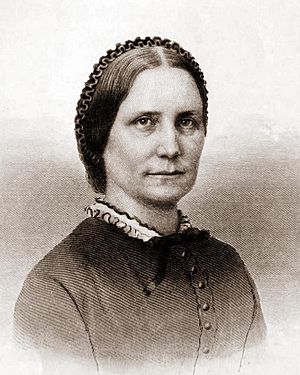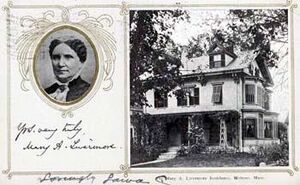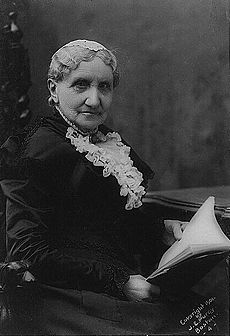Mary Livermore facts for kids
Quick facts for kids
Mary Livermore
|
|
|---|---|
 |
|
| Born | December 19, 1820 Boston, Massachusetts, U.S. |
| Died | May 23, 1905 (aged 84) Melrose, Massachusetts |
| Occupation | Journalist, abolitionist, advocate of women's rights |
| Notable works | My Story of the War |
| Spouse |
Daniel P. Livermore
(m. 1845) |
| Relatives | Mary Livermore Barrows (granddaughter) |
Mary Livermore (born Mary Ashton Rice; December 19, 1820 – May 23, 1905) was an important American writer, activist, and leader. She worked as a journalist, fought to end slavery, and was a strong supporter of women's rights.
During the American Civil War, Mary Livermore helped the United States Sanitary Commission. This group provided aid to soldiers. She organized events, visited hospitals, and wrote for newspapers. She even helped organize a big fair in Chicago that raised nearly $100,000. For this fair, she got President Lincoln's original copy of the Emancipation Proclamation, which was sold for $3,000.
After the war, she started a newspaper called The Agitator to support women's right to vote. Later, it joined with the Woman's Journal, where she was an editor. Mary Livermore also traveled a lot, giving speeches about women's right to vote and the temperance movement (which aimed to reduce alcohol use). She traveled about 25,000 miles each year, speaking five nights a week for five months!
Contents
Mary Livermore's Early Life and Schooling
Mary Ashton Rice was born in Boston, Massachusetts, on December 19, 1820. Her parents were Timothy Rice and Zebiah Vose (Ashton) Rice. Her family had a military background; her father fought in the War of 1812.
Mary was very smart. She finished Boston public schools when she was only 14. At that time, there were no public high schools or colleges for women. So, she went to a private all-female seminary in Charlestown, Massachusetts. She graduated in 1838. Her family was very religious, and she read the entire Bible every year until she was 23.
Mary Livermore's Career Beginnings
After graduating, Mary taught at the seminary for two years. In 1839, she became a tutor on a plantation in Virginia. Seeing slavery firsthand made her strongly oppose it, and she became an abolitionist. She also started working with the temperance movement around this time. She edited a newspaper for young people about temperance.
In 1842, she left the plantation. She then managed a private school in Duxbury, Massachusetts for three years. She also taught in Charlestown.
She married Daniel P. Livermore, a Universalist minister, in May 1845. In 1857, they moved to Chicago. Her husband started a Universalist newspaper called the New Covenant. Mary became an associate editor for twelve years, writing often for it.
Mary Livermore was a member of the Republican party. She campaigned for Abraham Lincoln in the 1860 presidential election. In 1860, she was the only woman reporter at the Chicago Wigwam, surrounded by hundreds of male reporters. In 1863, she published a collection of nineteen essays called Pen Pictures.
Mary Livermore's Role in the Civil War
When the American Civil War began, Mary Livermore was 40 years old. She volunteered for the United States Sanitary Commission in Chicago. This group helped soldiers by providing supplies and care. She organized many aid societies and visited army camps and hospitals.
In 1863, she helped organize the North-western Sanitary Fair in Chicago. This event raised $86,000 for the war effort. President Lincoln even donated his own copy of the Emancipation Proclamation, which was sold for $10,000 at the fair. Mary Livermore became a co-director of the Chicago branch with Jane Hoge. Together, they inspected hospitals in Illinois, Kentucky, and Missouri. They sent $1 million worth of food and supplies to hospitals and battlefields that needed them most.
Mary Livermore also wrote a lot during the war. She published articles and stories weekly. She wrote about her experiences in her 1887 book, My Story of the War. This book shared her four years of personal experience as a nurse and in relief work.
Mary Livermore's Work for Suffrage and Temperance
After the war, Mary Livermore focused on getting women's suffrage (the right to vote) and promoting the temperance movement. In 1868, she helped start the Chicago Sorosis Club with Myra Bradwell and Kate Doggett. This was the first women's group in Chicago to support women's right to vote. That same year, they held the first women's suffrage convention in Chicago.
In 1869, there was a disagreement among women's rights activists about voting rights for African American men. Mary Livermore supported Lucy Stone and helped found the American Woman Suffrage Association. That same year, she started and edited a newspaper called The Agitator, which focused on women's issues. She published 37 issues that year.
In 1870, the Livermores moved to Boston. Mary became very active in suffrage work there. The Agitator joined with the Woman's Journal, a well-known suffrage newspaper started by Lucy Stone. Mary Livermore became an associate editor for two years.
She also helped found the Massachusetts Woman Suffrage Association. She became president of the American Woman Suffrage Association. She was also the first president of the Association for the Advancement of Women.
Mary Livermore's Interest in Spiritualism
Mary Livermore was interested in spiritualism. This belief, which involves communicating with spirits, became popular after the Civil War. After her husband died in 1899, she believed she could still talk to him through a medium.
Mary Livermore's Death and Legacy
Mary Livermore died in Melrose, Massachusetts, on May 23, 1905.
An elementary school in Melrose, named the Mary A. Livermore School, was open from 1891 to 1933. In 1943, a World War II Liberty ship was named the SS Mary A. Livermore in her honor.
Selected Works by Mary Livermore
- The Children's Army (1844)
- Nineteen Pen Pictures (1863)
- What Shall We Do With Our Daughters? and Other Lectures
- My Story of the War: The Civil War Memories of the Famous Nurse, Relief Organizer and Suffragette (1887)
- The story of my life; or, The sunshine and shadow of seventy years (1897)
Images for kids
See also
 In Spanish: Mary Livermore para niños
In Spanish: Mary Livermore para niños




